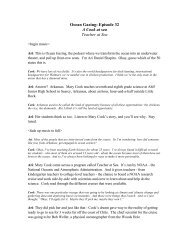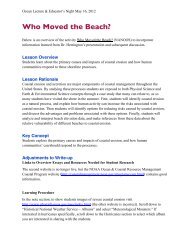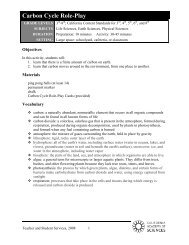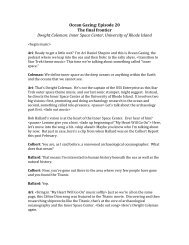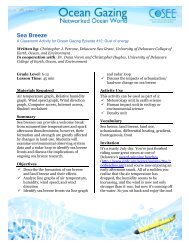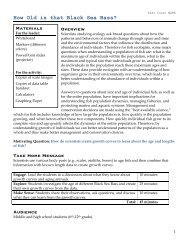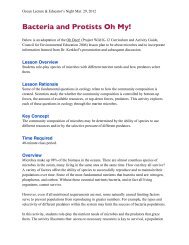Coral bleaching: A white hot problem (pdf) - cosee now
Coral bleaching: A white hot problem (pdf) - cosee now
Coral bleaching: A white hot problem (pdf) - cosee now
Create successful ePaper yourself
Turn your PDF publications into a flip-book with our unique Google optimized e-Paper software.
stress. <strong>Coral</strong>s are susceptible to a number ofstresses, both natural and human-induced,including pollution, sedimentation,increased temperature, and physicaldamage by humans. These stresses can killcoral reefs outright, or make the coralsmore susceptible to disease.Average global sea temperature has beenrising gradually over several decades, 0.7 °Cin the past 30 years alone, which isgenerally believed among the scientificcommunity to be due to global warming.This thermal stress can cause coral<strong>bleaching</strong>, or the loss of zooxanthellae fromthe coral tissues. Since the zooxanthellaeare what give the coral tissue their color, theloss of them make the coral appear <strong>white</strong>.With the loss of the p<strong>hot</strong>osynthetic algae,corals lose their primary food source andcan die.<strong>Coral</strong>s which had thrived for hundreds ofyears suddenly died in 1998. It was theworst year ever recorded globally for coral<strong>bleaching</strong> up to that point, and it broughtthe <strong>hot</strong>test sea surface temperatures since1982. View a NOAA animation of 1998’scoral <strong>bleaching</strong> <strong>hot</strong> spots (areas where thesea surface temperature exceeds theclimatological expected maximum for thatregion by 1° C or more, colored orange tored) and coral <strong>bleaching</strong> events (markedwith asterisks).In 2005, sustained high sea surfacetemperatures caused even worse coral<strong>bleaching</strong> in the Caribbean. According tosome scientists, the 2005 Caribbean<strong>bleaching</strong> events were bigger than all theprevious 20 years combined. The effectsfrom this are still being felt <strong>now</strong>. Recently,there was a large die off of corals off thecoast of Puerto Rico and the U.S. VirginIslands. These corals had survived the highheat of 2005 but were weakened andsuccumbed to <strong>white</strong> plague disease. Thefollowing data activity examines NOAAwater temperature data for San Juan,Puerto Rico for 2005 through 2008. We willcompare the observed water temperaturewith the k<strong>now</strong>n stressful temperature levelfor coral reefs and discuss the affects.Data Activity<strong>Coral</strong>s can survive in water temperatures upto 35 °C, however the optimal growthtemperature for corals is around 25 °C.Researchers have determined that, for anygiven area, water temperatures of 1 °Cabove the expected summertime maximumtemperature is stressful to corals. If an areaexperiences this it is called a coral <strong>bleaching</strong>HotSpot. If the thermal stress lasts for aweek or longer, the stress accumulates. Tomeasure this, researchers use a degreeheating week (DHW) value. If thetemperature is above the expected averagemaximum for one week, the DHW is 1. Ifthe temperature is 2 °C higher than theexpected maximum for one week then theDHW value is 2. You can also get a DHWvalue of 2 if the temperature is 1 °C higherfor 2 weeks.For Puerto Rico, the expected summertimemaximum temperature is 28.5 °C. Thismakes the DHW level 29.5 °C.Print the following graphs of observed dailywater temperature for San Juan, PuertoRico for 2005 - 2008. These data werecollected by the NOAA National Data BuoyCenter. Each year has its own graph, andthe last graph shows all years (2005 - 2008)compiled.In the graphs, the vertical lines mark oneweektime periods. The yellow line marksthe 1 DHW level of 29.5 °C and the red linemarks the 2 DHW level of 30.5 °C.A study conducted by researchers from theUniversity of Puerto Rico found that 54<strong>Coral</strong> Bleaching: A White Hot Problem Page 2



